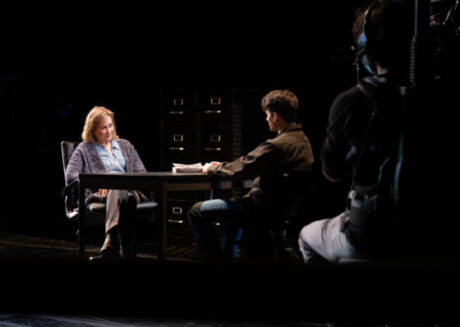
Photo by Cody Nieset)
3 stars
“The Sound Inside,” by Adam Rapp, the Jefferson Award winning and Pulitzer Prize nominated playwright of “Red Light Winter,” is a perfect choice for Goodman Theatre’s first live performance on its Owen Theatre stage.
A 90-minute drama that will have audiences wondering what happens next, the play follows the high intensity interaction between a Yale professor who teaches a writing class and a student.
The difference in watching this play from last year’s pre-pandemic, in-person shows and the streaming plays mounted in 2020 and still going on, is that the audience is not filling Owen’s seats and that the action is not pre-taped.
Viewers are at home watching the action as it happens. (Camera angles are important and included in the photos)
Because some scenes seem to be wordy and others might make audiences who think too much information might want to fast forward, which of course, they can’t, the fact that this is live is actually good.
What may sound like background information is crucial to the psychological buildup behind each character’s behavior, responses and the play’s conclusion.
The characters are Bella Lee Baird, interpreted brilliantly by Mary Beth Fisher as a 50-something creative writing professor who is struggling with a recent diagnosis of stage 2 cancer, and Christopher Dunn, superbly played by John Drea as an antisocial, anti- technology freshman in her Reading Fiction for Craft course.
Christopher sees Twitter as an outlet for those people “scared of loneliness.” Bella who somewhat narrates the actions, describes herself as unremarkable and the equivalent of a “collectible plate on the wall.”
Not so incidentally, Rapp’s mother’s maiden name was Mary Lee Baird. She died in 1997.
Director Robert Falls cloaks the opening scenes in darkness. They mirror Bella’s mood as she describes the dark park where she comes at night when she can’t sleep. She says the park is “filled with trees that look arthritic.”
Bella then recalls her mother’s illness and death and wonders what she could have done wrong to bring on cancer because she eats healthfully and doesn’t overdo anything.
The scenes between the two characters contain a minimal number of props and lighting so that the audience can focus on Bella’s and Christopher’s changing relationship and the information slowly released about a book he is writing and about a book Bella wrote.
Among the worrisome and telling features of “The Sound Inside” is that both books are tragic and that Christopher believes good, successful authors commit suicide. He names several.
Another telling point is Christopher’s response to Bella’s use of Dostoyevsekyh’s “Crime and Punishment” to discuss antiheros as in the murder of the pawnbroker and his sister. Christopher cries, “Someday, I’m going to write a moment like that.”
“The Sound Inside,” is streaming live from May 13 –16. Running time: 90 minutes.
“Ohio state Murders’ streams live June 17-20. “I Hate It Here streams live July 15-18, 2021. Individual tickets are $30. Three productions tickets with a Live Membership is $60..
For tickets and more information visit Goodmantheatre/live.
For more shows visit Theatre in Chicago
Jodie Jacobs

